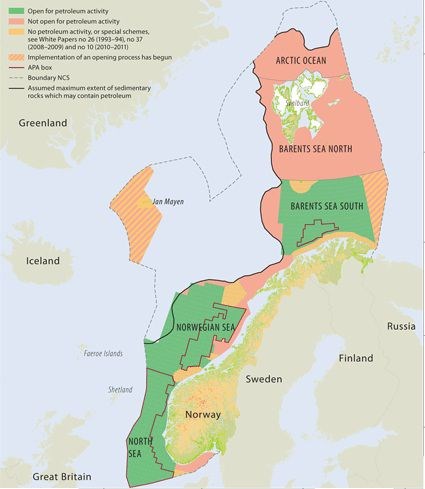Opening the Area around Jan Mayen for Petroleum Activities – Public Hearing on Impact Assessment
Historical archive
Published under: Stoltenberg's 2nd Government
Publisher: Ministry of Petroleum and Energy
Press release | Date: 22/10/2012
The Ministry of Petroleum and Energy last week submitted an impact assessment relating to petroleum activities in the area around Jan Mayen on public hearing. Interested parties are invited to comment on the impact assessment within the next three months.
The Ministry of Petroleum and Energy last week submitted an impact assessment relating to petroleum activities in the area around Jan Mayen on public hearing. Interested parties are invited to comment on the impact assessment within the next three months.
The impact assessment forms part of the process of opening areas on the Norwegian Continental Shelf around Jan Mayen for petroleum activities. A geological survey has also been undertaken. Given that the impact assessment provides a basis for doing so, the government will present a white paper to the Storting, recommending that the area be opened for petroleum activities.
“The maritime areas around Jan Mayen may contain substantial oil and gas resources. The impact assessment is now being submitted for public hearing so that interested parties may give feedback and contribute to quality assurance of the studies that have been carried out,” says Minister of Petroleum and Energy Ola Borten Moe.
The Norwegian Petroleum Directorate has previously carried out limited studies of the oil and gas potential of the areas around Jan Mayen. As part of the opening process, the Directorate undertook a new geological survey in 2011 and 2012. The initial results of the survey will be presented in early 2013.
The impact assessment summarises technical reports prepared by government agencies and independent expert institutions. The reports cover matters defined in an impact assessment programme that was finalised following a public hearing in the autumn of 2011.
One finding of the impact assessment is that a major, sudden oil spill may have a negative environmental effect, but the probability of such an incident occurring is very low.
The impact assessment is being submitted for public hearing to give affected parties an opportunity to comment on the work undertaken thus far. The aim is to ensure a high level of technical quality. Three months are allocated for consultation on the impact assessment. Comments must be submitted to the Ministry of Petroleum and Energy by 16 January 2013.
The impact assessment, comments received through the public hearing and the assessment of the resource potential will form the technical basis for a possible decision to open the area for petroleum activities.
The Ministry is at the same time initiating a public hearing on an impact assessment relating to the Barents Sea South-East.
###
BACKGROUND INFORMATION
Section 3-1 of the Petroleum Act requires an opening process to be completed before any area on the Norwegian Continental Shelf may be opened for petroleum activity. The Petroleum Act confers authority to conduct resource management, including the opening processes, to the Ministry of Petroleum and Energy. The purpose of an opening process is to examine the basis for a decision of the Storting (the Norwegian parliament) to open an area for petroleum activities.
The opening process consists of two parts. The first is a survey of the geology, and thus the resource potential, of the area. The second part is an impact assessment. The aim of the impact assessment is to produce a basis for balancing different interests and issues of significance to a recommendation to open the area for petroleum activities. The report must contain an assessment of the anticipated commercial and environmental impacts of petroleum activity, the potential risk of pollution, and the economic and social effects of petroleum activity in the area. Such an assessment is undertaken through the preparation of an impact assessment under the auspices of the Ministry of Petroleum and Energy.

Jan Mayen is part of the Kingdom of Norway. The island and the rock underneath it are considered to be entirely volcanic. Most of the micro continent located south of the island is covered or influenced by lava rock, but it also comprises rock that offers possibilities for oil and gas discoveries. The geological data available for the area has been insufficient to allow the Norwegian Petroleum Directorate to estimate the petroleum resources in the area. The geological survey that has been conducted by the Norwegian Petroleum Directorate will increase the knowledge, but the amount of producible resources can only be clarified through opening and subsequent exploration drilling.
Norway and Iceland have agreed to establish a special cooperation area relating to petroleum activity in a defined area located between Iceland and Jan Mayen (see map). Iceland is currently completing its second licensing round, and plans to award production licences towards the end of 2012.
The involvement and quality assurance of affected parties are important elements in the impact assessment process. Both the proposed programme for the impact assessment and the impact assessment itself are therefore being submitted for public hearing. The programme for the impact assessment was finalised in the autumn of 2011, based on current knowledge. Extensive survey work has been conducted to obtain additional, updated knowledge. The impact assessment summarises the updated and extended knowledge base.
More information about the opening process and all of the specialist reports that underpin the impact assessment can be found on the website of the Ministry of Petroleum and Energy (The reports are in Norwegian only, some summaries are translated to English).